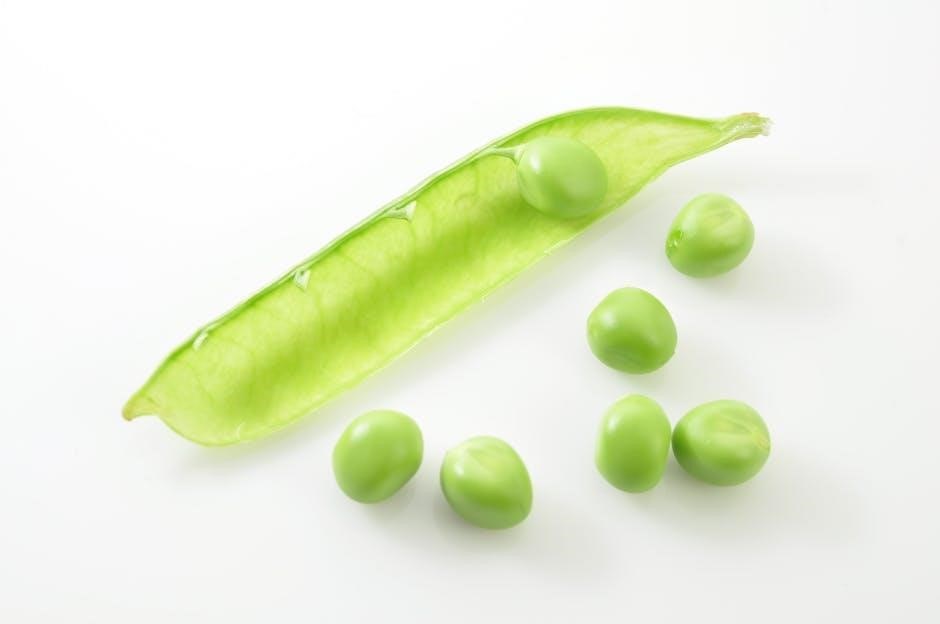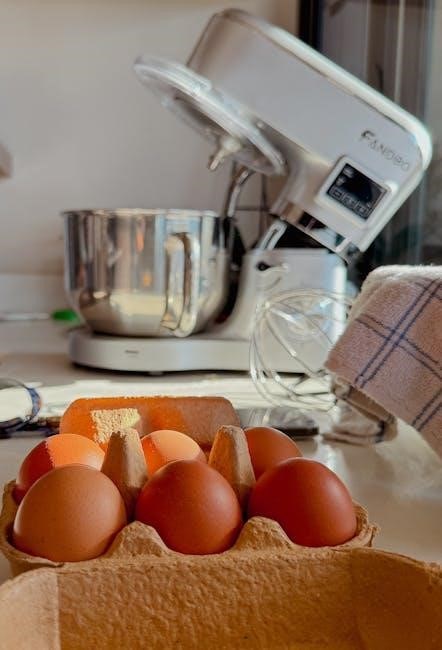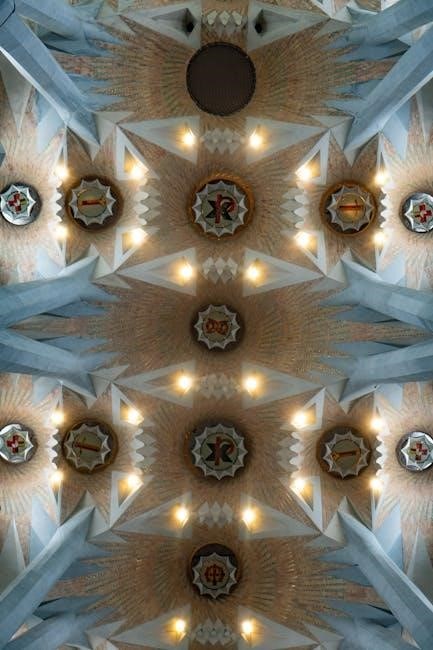
pdf modernist cuisine
Modernist Cuisine: The Art and Science of Cooking, by Nathan Myhrvold, Chris Young, and Maxime Bilet, is a groundbreaking six-volume cookbook that revolutionizes culinary techniques.
1.1 Definition and Core Principles
Modernist Cuisine redefines cooking by blending science, creativity, and tradition. It emphasizes precision, experimentation, and understanding the chemical and physical transformations in food; Core principles include the use of scientific techniques like sous vide, foamification, and spherification, alongside innovative tools such as centrifuges and lasers. The approach focuses on deconstructing dishes to enhance flavors and textures, while maintaining nutritional integrity. By applying scientific rigor, Modernist Cuisine empowers chefs to innovate and push culinary boundaries, creating a new language of gastronomy that is both artistic and technically precise. This philosophy democratizes high-end techniques, making them accessible to home cooks and professionals alike;
1.2 Historical Context and Evolution
Modernist Cuisine emerged in the late 20th century, rooted in molecular gastronomy and the scientific study of cooking. Pioneers like Ferran Adrià and Heston Blumenthal laid the groundwork. The 2011 publication of Modernist Cuisine: The Art and Science of Cooking by Nathan Myhrvold, Chris Young, and Maxime Bilet systematized these techniques, making them accessible. The movement emphasizes innovation, experimentation, and understanding the science behind food preparation. It has since evolved, influencing global culinary practices and inspiring both professional chefs and home cooks to adopt its principles, blending tradition with cutting-edge methods to redefine the future of cooking.
The Role of Nathan Myhrvold and His Team
Nathan Myhrvold’s pioneering work in Modernist Cuisine revolutionized cooking through scientific exploration. His team’s comprehensive guide transformed culinary practices, blending art and science for culinary innovation.
2.1 Nathan Myhrvold’s Background and Contributions
Nathan Myhrvold, a polymath and former Microsoft CTO, brought his scientific expertise to culinary arts. His work in Modernist Cuisine combined chemistry and cooking, creating a new paradigm. As the book’s author and photographer, he introduced techniques like sous-vide and foamification. Myhrvold’s contributions include demystifying complex cooking methods and making them accessible. His passion for photography also elevated the book’s visual appeal, showcasing dishes in an artistic yet educational manner. This blend of science, creativity, and precision cements his legacy as a pioneer in modern gastronomy. His work continues to inspire chefs and home cooks alike.
2.2 The Collaboration with Chris Young and Maxime Bilet
Nathan Myhrvold collaborated with Chris Young and Maxime Bilet, both culinary experts, to create Modernist Cuisine. Chris Young, with a background in chemistry and cooking, brought technical precision, while Maxime Bilet contributed artistic flair and culinary creativity. Their teamwork resulted in a comprehensive exploration of modern gastronomy, blending science with innovative techniques. Together, they developed groundbreaking methods and recipes, making complex culinary processes accessible. Their collaboration also extended to related projects, such as Modernist Cuisine at Home and The Photography of Modernist Cuisine, further solidifying their impact on contemporary cooking.

The Structure and Content of Modernist Cuisine
Modernist Cuisine is a six-volume, 2,400-page masterpiece that systematically explores culinary techniques, ingredients, and scientific principles. It covers everything from basic cooking methods to advanced molecular gastronomy.
3.1 Overview of the Six-Volume Set
The six-volume set of Modernist Cuisine is an encyclopedic guide to modern cooking. It spans 2,400 pages, covering foundational techniques to cutting-edge innovations. Volume 1 introduces the science and art, while Volume 2 focuses on techniques and equipment. Volumes 3, 4, and 5 delve into specific categories like meats, vegetables, and plated dishes. The final volume, Modernist Cuisine at Home, simplifies recipes for home cooks. The set is a comprehensive resource for chefs and culinary enthusiasts, blending practicality with scientific insights into food preparation.

3.2 Key Techniques and Recipes Explored
Modernist Cuisine delves into groundbreaking techniques like sous vide, spherification, and foamification, each explained with scientific precision. Recipes showcase innovative applications, such as creating spheres from liquids or airy foams. The book also explores dehydration, gelification, and emulsification, offering creative approaches to texture and presentation; Tools like centrifuges and ultrasonic homogenizers are highlighted, alongside ingredients like sodium alginate and xanthan gum. These methods enable chefs to reinvent classic dishes and craft futuristic culinary experiences, making the book an indispensable resource for culinary innovation. The techniques are paired with detailed recipes, ensuring practical application of modernist principles.

The Photography and Visual Elements
Nathan Myhrvold’s stunning photography in Modernist Cuisine captures the science and art of cooking, using minimal digital editing to reveal the beauty of culinary processes and creations. The images, often shot inside ovens or during spherification, provide a unique visual narrative. A separate book, The Photography of Modernist Cuisine, further highlights his work, showcasing food’s natural phenomena and technique-driven transformations. These visuals complement the recipes, making the cookbook a feast for both the eyes and the mind.
4.1 The Photography of Modernist Cuisine Book

The photography in Modernist Cuisine is a masterclass in culinary storytelling. Nathan Myhrvold’s images capture the science and art of cooking with striking precision, using minimal digital manipulation. From high-speed shots of spherification to close-ups of molecular transformations, the visuals reveal the magic of modernist techniques. The book’s photography is so iconic that it inspired a standalone volume, The Photography of Modernist Cuisine, showcasing Myhrvold’s ability to make food both visually stunning and intellectually fascinating. These images not only complement the recipes but also serve as a bridge between culinary innovation and visual artistry, making the cookbook a true masterpiece.
4.2 Visual Storytelling in the Cookbook
Visual storytelling in Modernist Cuisine elevates the cookbook to an art form. Nathan Myhrvold’s photographs and illustrations provide a detailed narrative of culinary techniques, transforming complex processes into digestible visuals. Cross-sectional images of cooking equipment, like ovens and grills, reveal inner workings, while step-by-step photos guide readers through intricate recipes. The visuals demystify modernist methods, making them accessible to both professionals and home cooks. This interplay of art and instruction creates a immersive experience, proving that cooking is as much about visual understanding as it is about taste and technique, setting a new standard for culinary education.

The Impact and Legacy of Modernist Cuisine
Modernist Cuisine has redefined culinary standards, inspiring chefs globally with its scientific approach. Its influence transformed gastronomy, making it a foundational text for modern cooking innovation and education.
5.1 Influence on Modern Gastronomy
Modernist Cuisine has profoundly shaped modern gastronomy, introducing chefs to scientific techniques like sous-vide and foamification. Its emphasis on precision and innovation has inspired a new wave of culinary creativity, enabling chefs to experiment with novel textures and flavors. The book’s detailed exploration of food science has democratized advanced cooking methods, making them accessible beyond elite restaurants. This shift has fostered a culture of experimentation, pushing the boundaries of traditional cooking and influencing menus worldwide. The cookbook’s impact is evident in the proliferation of modernist dishes across fine dining and casual eateries alike.
5.2 Cultural and Culinary Significance
Modernist Cuisine has transcended traditional cookbooks, becoming a cultural landmark in gastronomy. It bridges food and science, inspiring chefs and home cooks alike to rethink cooking. Its detailed techniques and creative approaches have reshaped culinary education, making it a cornerstone of modern kitchens. The book’s visual and intellectual depth has elevated it to a collector’s item, symbolizing innovation in food culture. Its global influence has fostered a community of culinary explorers, ensuring its enduring legacy as both a practical guide and a cultural phenomenon, forever changing how we perceive and prepare food.
Resources for Further Exploration
Explore Modernist Cuisine in PDF format on platforms like LIBRARYSHARE.NET. Discover related books, such as Modernist Pizza, and exhibitions showcasing Nathan Myhrvold’s culinary innovations.

6.1 Where to Find Modernist Cuisine in PDF Format
The complete six-volume set of Modernist Cuisine: The Art and Science of Cooking is available in PDF format on platforms like LIBRARYSHARE.NET. Readers can also explore the official website for digital versions and additional resources. The PDF edition provides unparalleled access to Nathan Myhrvold’s groundbreaking culinary science, making it a must-have for gastronomy enthusiasts. Additionally, the photography book and Modernist Cuisine at Home are available digitally, offering a comprehensive exploration of modern cooking techniques and artistic presentation.
6.2 Related Books and Exhibitions
Beyond the original six-volume set, enthusiasts can explore Modernist Cuisine at Home and Modernist Pizza, which extend the culinary journey. Exhibitions showcasing the book’s photography, like The Photography of Modernist Cuisine, offer visual insights. These resources, along with digital editions, provide a comprehensive understanding of modern gastronomy, making them essential for culinary innovators and food enthusiasts alike.